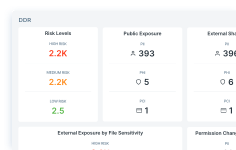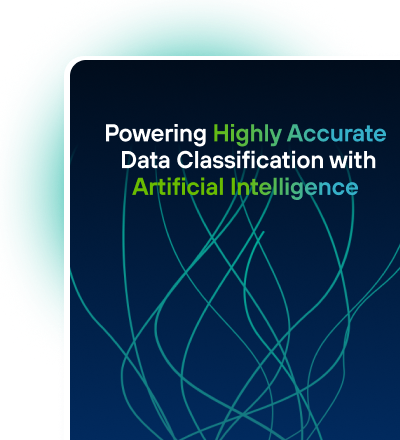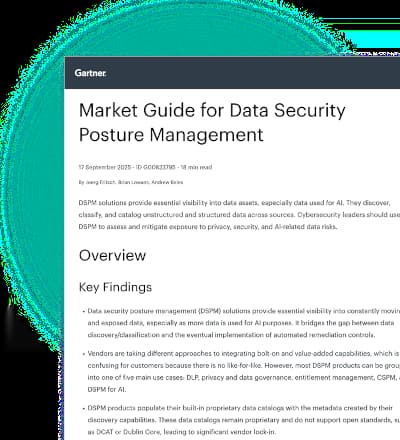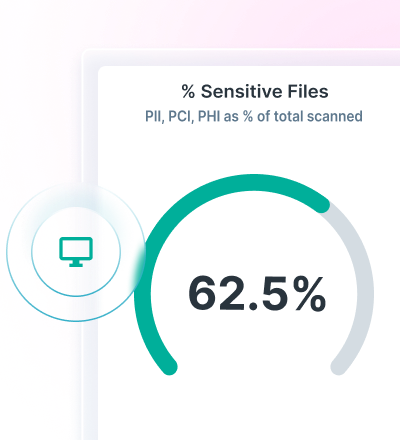Data is digital gold for individuals, businesses and governments alike. And as the modern workplace rapidly transitions to hybrid workforces and cloud-based services, an evolving threat landscape means organizations must give data the time, attention and technology necessary to keep it safe.
This means protecting sensitive and proprietary information from data leaks and data breaches is as big a part of success as protecting profits.
In this Guide
Get explanations of key concepts relating to data security along with links to additional resources and tools to help you understand and successfully implement data security best practices.
Data Security Fundamentals
What is Data Security?
Data security refers to all the practices and measures enacted to protect data from unauthorized access, use, disclosure, disruption, modification or destruction. It covers a wide range of techniques, technologies, policies and procedures designed around the concept of data loss prevention to ensure its confidentiality, integrity and availability.
A data security breach can lead to severe consequences, including financial losses, reputational damage, legal liability and a loss of public trust. Organizations and individuals have a vested interest in maintaining the security of their data to prevent threat actors from accessing it.
The progress of technology and the growing interconnection of data cause new challenges and risks to emerge over time. The rise of cloud computing, mobile devices and the Internet of Things (IoT) expanded the attack surface for many organizations and increased the complexity of data security. Now, a generative Artificial Intelligence (AI) revolution is reinventing data risk, yet again.
Because of this continuing trend, a holistic approach to data security that considers the entire data lifecycle is indispensable. At Forcepoint, this includes giving acute attention to the discovery, classification, prioritization, protection and monitoring of data across the enterprise.
When properly implemented, data security involves multiple layers of protection, such as:

Physical security
- Role-based access controls
- Video surveillance
- Secure storage facilities
- Security personnel
Technical safeguards
- Data Loss Prevention software
- Encryption
- Multi-factor authentication mechanisms
- Firewalls
- Intrusion prevention systems
- Antivirus software
Policies and procedures
- Data classification levels
- Data retention and destruction practices
- Employee training for data security best practices
Types of Data Security
Data risk stems from the applications that data passes through and is used in. Because of this, there are several subtypes of data security that organizations must be aware of.
Whether you employ a piecemeal or comprehensive approach to applying security solutions, it is important to consider these key concepts within your data security strategy.
Data Loss Prevention DLP
Learn Moreis the collection of measures used to prevent data from being lost, accessed by unauthorized users or leaked, either accidentally or purposefully. DLP technology monitors data as it flows in and out of an organization and blocks sensitive data from leaving.
Zero Trust Security
Learn Moreis an approach that assumes every request for access to data, applications or other sensitive resources is a threat. Zero Trust principles aim to continuously authenticate and validate user access and to prevent malicious actors from using a single point of access to move laterally throughout a secure network.
Cloud App Security
Learn Morerefers to protecting applications and data in cloud environments, beyond the data protection that cloud vendors provide from an infrastructure perspective. This is of growing importance as organizations migrate data and assets from on-premises data centers to the cloud, and use of Software-as-a-Service (SaaS) proliferates.
Network DLP
Is a practice that monitors data at rest, in motion and in use across the network. It provides further policy enforcement for regulatory compliance, and gives organizations another view into potential data exfiltration.
Email DLP
Learn MoreFocuses on preventing data exfiltration via email. This is achieved by DLP that blocks data from leaving through context-aware DLP, implements encryption and educates users about best practices for data protection.
Endpoint DLP
Learn Moreis the practice of securing endpoints, i.e., end-user devices and interfaces such as computers, tablets and smartphones. Endpoints create points of entry to an enterprise network for malicious actors, and the risk increases when employees use unmanaged personal devices to access corporate data.
The Different Types of Data
and How to Secure Them
While a company may collect, store and process information in dozens of different formats, it all boils down to two types of data:
- Structured data, which has a defined template for display and is easily organizable and identifiable. Structured data is often quantitative, such as social security numbers, birthdays or transactions.
- Unstructured data, which is less defined and can come in a variety of formats. Unstructured data is often qualitative, such as blueprints, documents or images.

From there, organizations generally apply data security to three strategic areas:
- Big data: Large volumes of information collected from various sources to fuel predictive modeling, targeted advertising, preventive maintenance and other forms of data analytics.
- Sensitive data: Personal information collected that contains financial, medical or otherwise personally identifiable information.
- Business-critical data: Confidential information that defines a company’s competitiveness, such as intellectual property, or is vital to its day-to-day operations, like financial metrics.
Data security will look different depending on the type of data the organization is seeking to protect. Generally, companies will use a suite of solutions to discover, classify, prioritize, protect and monitor interactions with this data. They’ll layer in a mix of preventive measures, such as data masking and data encryption, with active strategies such as data loss prevention for a comprehensive approach.
Data Security vs. Data Privacy
Data security and data privacy are closely related concepts that both have separate resourcing, strategy and technological requirements.
Data security focuses on protecting data from unauthorized access, maintaining its integrity and availability, and preventing it from leaving the organization. This extends to many aspects of a user’s day-to-day routine, and at Forcepoint this largely covers activities in the cloud, web, email, network and endpoint.
Data privacy covers the ethical and legal responsibilities of organizations when handling personal information and respecting individuals’ privacy rights. These responsibilities change from country to country but are often tied to industry-specific data privacy laws, such as the Health Insurance Portability and Accountability Act (HIPAA), or broad data regulations, such as the General Data Protection Regulation (GDPR).
Data security and data privacy often go hand in hand due to regulatory reporting requirements. At Forcepoint, this can be enforced by DLP software in the form of data security policies. Both aspects are crucial for maintaining trust with customers and regulators.
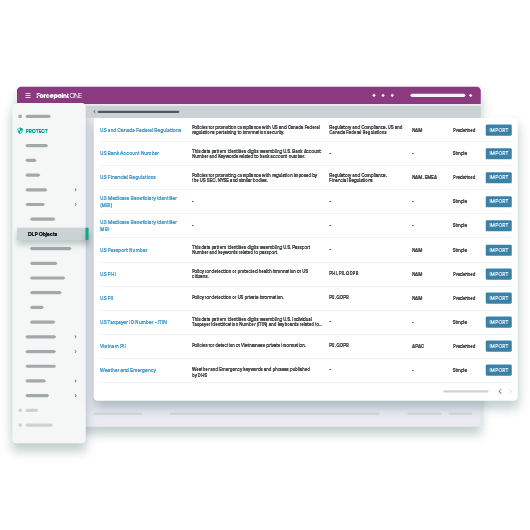
Key aspects of data privacy include:
- Obtaining consent before collecting or using personal data
- Collecting and processing data only for specific purposes
- Collecting and retaining only the minimum amount of personal data necessary
- Removing or encrypting personal identifiers to anonymize data
- Respecting the rights of individuals to access and correct their personal data or to restrict its use
- Notifying individuals and authorities of data breaches
Because of how much data organizations produce and are responsible for, a comprehensive approach to securing it is critical. Proactive practices such as data classification, data discovery, data encryption and DLP are useful for prioritizing, protecting and monitoring data.
Data Security Regulations
Governing bodies worldwide put data security regulations in place to ensure organizations take the proper care to safely collect, store and use sensitive information.
Any viable data security strategy must include the ability to ensure and demonstrate compliance with the pertinent regulations. A few of the key regulations that may impact your data policies are:

GDPR
The General Data Protection Regulation (GDPR): EU and EEA member states are bound by this regulation governing the collection and use of personal data, which also serves as a model for many privacy laws emerging worldwide.

HIPAA
The Health Insurance Portability and Accountability Act (HIPAA): Healthcare records in the United States are governed by HIPAA, which can now be more effectively enforced via the Health Information Technology for Economic Clinical Health (HITECH) Act of 2009.

PCI DSS
The Payment Card Industry Data Security Standard (PCI DSS): This standard was developed by leading credit card companies and is intended to ensure the safe and secure transfer of credit card data and to prevent fraud.
Depending upon the countries and industries in which you operate, there are numerous regulations that may affect your approach to both data security and data privacy.
Some organizations will turn to DLP software to assist with compliance. Forcepoint DLP offers out-of-the-box data security policies that map to your local data privacy regulations – while others provide a roadmap but require more work to get them to map correctly.
Being aware of all of these and having an active compliance plan in place for each one should be a critical component of any organization’s security operations.
Data Security Challenges and Trends
Data security has sat front and center in organizations’ minds for the better part of the last 30 years.
From the first e-commerce transaction and the introduction of health portals in the 1990s, to the proliferation of Software-as-a-Service (SaaS) and social media in the 2010s, companies across every industry have been regularly collecting and processing data ranging in the hundreds of terabytes.
The sensitive information, ranging from social security and credit card numbers to unreleased movies or video games, is a prime target for threat actors due to its value on the black market and its potential disruption to the business.
Unsurprisingly, countries across the world have moved quickly to implement regulations designed to curb the data businesses can collect, enforce better handling of that data, and to ensure organizations are securing that data with the utmost care possible.
These trends have led to the following data security challenges that will be pervasive throughout 2023 and beyond:
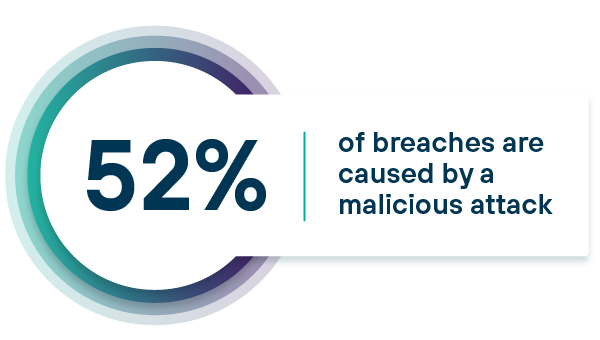
Threat protection
Social engineering, malware and supply-chain attacks have become commonplace and a major source of data breaches. In fact, IBM reports that 52 percent of breaches are caused by a malicious attack. Phishing, ransomware and zero-day threats put data such as Personally Identifiable Information or intellectual property at risk.
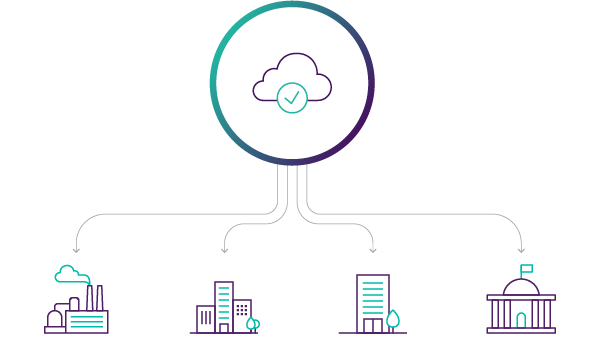
Hybrid-work environments
Cloud applications power businesses these days. While they enable employees to work from anywhere, cloud applications also create new risks for organizational data security. It is increasingly difficult for companies to gain visibility into the data and its usage on these platforms, and to control access to only those who are trusted. As a result, many data leaks and breaches are the result of poor data security in the cloud.
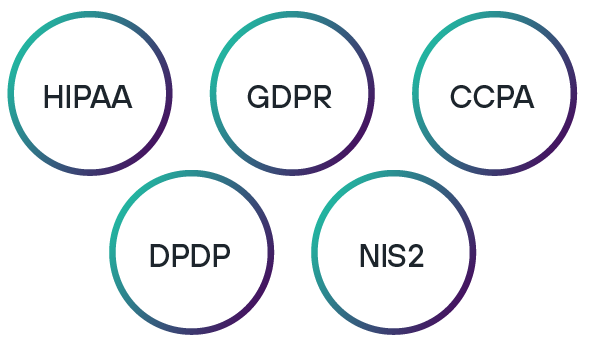
Regulatory scrutiny
The General Data Protection Regulation (GDPR) in Europe and the California Consumer Privacy Act (CCPA) in the US were the start of a deluge of data privacy and security concerns turning into mandatory compliance. Organizations must grapple with competing regulatory responsibilities dictating how they should store and secure data – and prove to auditors that they are maintaining compliance. With further privacy laws such as the Digital Personal Data Protection (DPDP) bill in India and the NIS2 Directive in Europe now on the way, businesses must continue to invest in data security to avoid noncompliance.
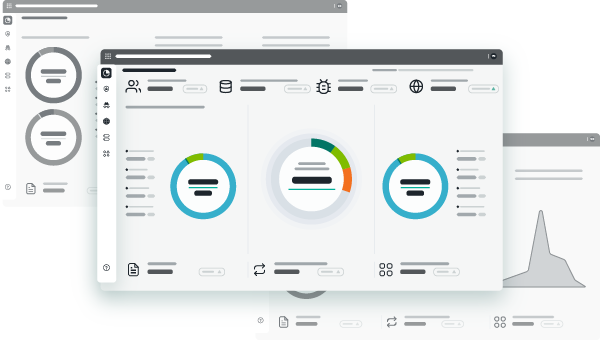
Fractured technology stack
As organizations face more cybersecurity threats and the attack surface grows through the years, security technology stacks have grown alongside it. There are thousands of vendors selling niche solutions that don’t always interact cleanly with each other, creating false alerts that drain the time of security teams which are already stretched thin. Add in data security policy creation and maintenance, which continues to expand with the attack surface, and it’s easy to see why unified security tools and data security policies are trending among medium-sized and large businesses.
The Data Security Threat Landscape
The threat landscape is constantly shifting in response to new innovations from both security practitioners and malicious actors alike, meaning that sound data security practices must involve more than simply applying strategies that have worked in the past.
Cyberthreats like ransomware and malware capture headlines because of the financial and operational damage they wreak. Countless organizations across the world have admitted to paying ransom to get their data and systems back online, and others like the NHS have felt reverberations for even one day of downtime.
But there are other, less obvious data security threats. Open buckets on AWS are a popular origin for data leaks, when practitioners remove security controls during migrations to make things easier for themselves – leaving the instances unguarded and vulnerable to data leaks.
Now, with the popularity of cloud services like Google Docs, Slack and countless other productivity tools, organizations have even more risk to cover off in their data security strategy. Not only do IT teams need to ensure the SaaS vendors keep their infrastructure secure, but they need to gain visibility into what data employees are working with on these platforms. This risk is amplified with the rise of generative AI, which can learn off the data that is being shared.
Data Security Risks
There are numerous types of data security risks, and the list has only expanded with new hacking and social engineering techniques continuously emerging.
While large cyberattacks tend to garner headlines, not all data security risks are the product of intentional malicious action. In fact, major risks can result from unintentional behaviors that cause sensitive data to be released into unsecured spaces where it can be stolen or exploited.
Data security risk categories include:
- Data exfiltration: This broad concept refers to any unauthorized movement of data, whether accidental or malicious. Outbound emails, downloads to insecure devices and uploads to external devices are some of the actions that can lead to data exfiltration.
- Data leakage: Falling under the umbrella of data exfiltration, data leakage more specifically refers to the unauthorized transmission of data from within an organization to an external destination or recipient. The term can be used to describe either the electronic or physical transfer of data. Data leakage threats usually occur via the web and email, but they can also happen through mobile data storage devices such as laptops and USB keys that are lost, stolen or intentionally used to transfer sensitive information.
- Phishing: Phishing refers to the fraudulent use of electronic communications to deceive and take advantage of targeted individuals. Email is the traditional medium for phishing, but increasingly attackers use additional avenues such as SMS, social media and phone calls. Phishing involves the use of social engineering to manipulate victims into performing specific actions – such clicking on a malicious link or downloading an attachment – or giving up confidential information such as account credentials. There is a growing list of specialized phishing approaches – spear phishing, clone phishing and whaling are a few – as attackers constantly devise new strategies.
Data security risks are a concern for everyone from the largest enterprises to small business, and the consequences of a breach can be devastating. It’s a huge reason why so many organizations turn to Forcepoint for help in securing their data.
To give a sense of the scale of the problem, 2022 saw a total of over 1 billion records exposed and over $5.3 billion in losses and fines incurred. In addition to the short-term financial impact of data security risks, breaches frequently lead to losses of customer confidence and brand value that can jeopardize the long-term viability of organizations.
Securing Data
Data Security Solutions
Organizations need to employ purpose-built data security solutions to mitigate risks. But not all solutions are one-size-fits-all like Forcepoint is.
Data security strategies must incorporate multiple solutions to provide all the capabilities needed to protect against modern threats and ensure responsible stewardship of sensitive data. Several factors distinguish Forcepoint data security solutions from underperforming competitors.
Organizations should be able to cover off a couple of different of activities with their data security solutions. These include:
- Discovering data that is both actively used and redundant, obsolete or trivial.
- Classifying data to get an accurate picture of what data the organization has and evaluate its criticality.
- Prioritizing data that needs to be secured based on a variety of criteria.
- Protecting data through robust data security controls.
- Monitoring the flow of data throughout the business to ensure comprehensive coverage.
Data Security Technologies
On-premises vs. SaaS
Deciding on which data security technologies to adopt should start by asking how the organization needs them to be hosted.
On-premises solutions are hosted internally and can be cost-effective to maintain after the initial cost of implementation. A Software-as-a-Service (Saas) solution is hosted by a third-party provider and stores data in a secure data center in the cloud. SaaS solutions are more scalable for growing organizations, and they are not vulnerable to catastrophic data loss if an internal data center is damaged by a disaster such as fire or flood.
Forcepoint data security solutions can be deployed in a variety of ways to meet the needs of every business.
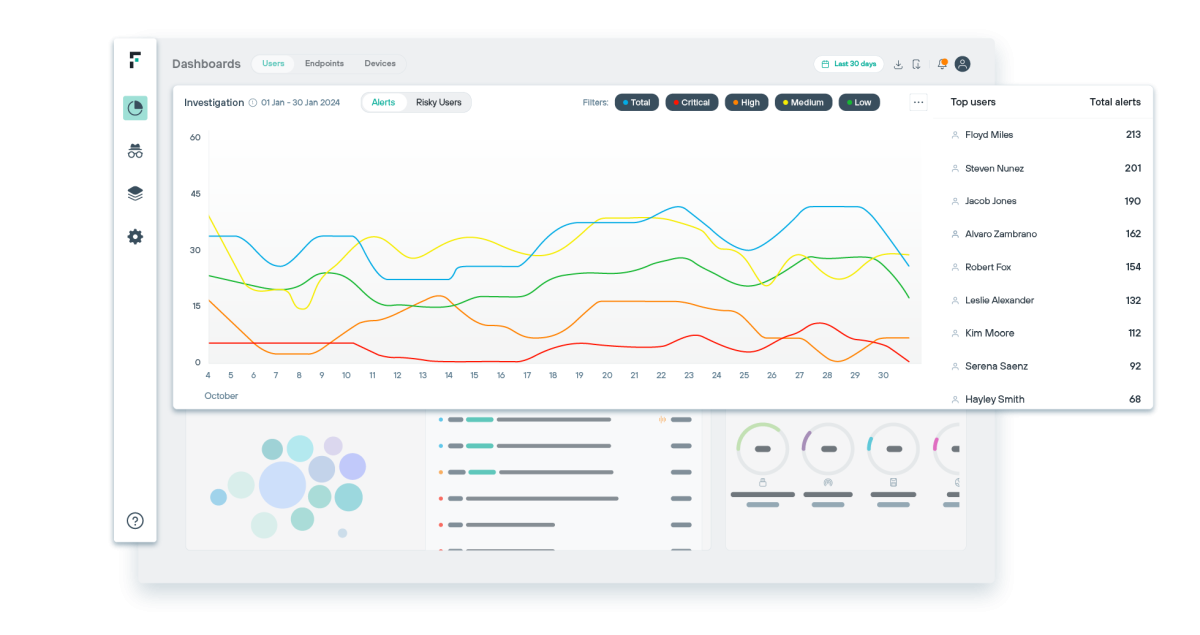
Forcepoint ONE Data Security
Forcepoint ONE Data Security is a cloud-native DLP SaaS that enables enterprises to safeguard sensitive information and enforce compliance through one platform. It streamlines modern data security by its ability to:
- Unify policy management across cloud, web, email and endpoint
- Build and provision policies in minutes using a library of 1,700+ classifiers and templates
- Monitor and remediate incidents in real time through policy enforcement, including built-in Risk-Adaptive Protection
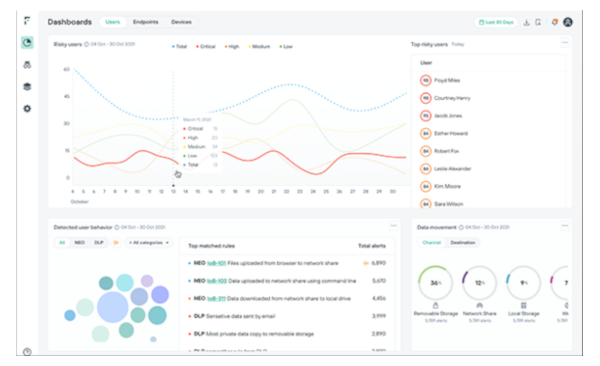
Risk-Adaptive Protection
Forcepoint Risk-Adaptive Protection applies a behavior-centric approach to data security, examining how users interact with data to better understand their intent. This allows organizations to:
- Maintain productivity by allowing low-risk users to work unimpeded
- Minimize false positives to avoid overloading security practitioners
- Unlock broad monitoring capabilities across 100+ Indicators of Behaviors (IOBs)
- Automatically limit access when users display uncharacteristic behaviors that could indicate compromise
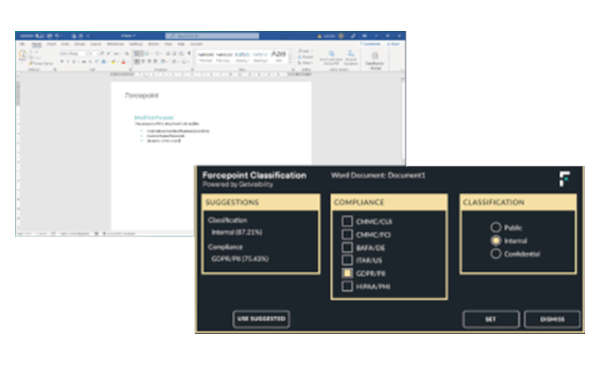
Data Classification
Forcepoint Data Classification uses Machine Learning (ML) and Artificial Intelligence (AI) to more accurately classify unstructured data, keeping critical information safe and boosting productivity. Powered by cutting-edge AI models, it can:
- Accurately and efficiently determine how data should be classified, at scale
- Cover the broadest range of data types in the industry to drive efficiency and streamline compliance
- Seamless deploy with no user training, integrating with Forcepoint Enterprise DLP to allow organizations to select the requirements and criteria for data classification
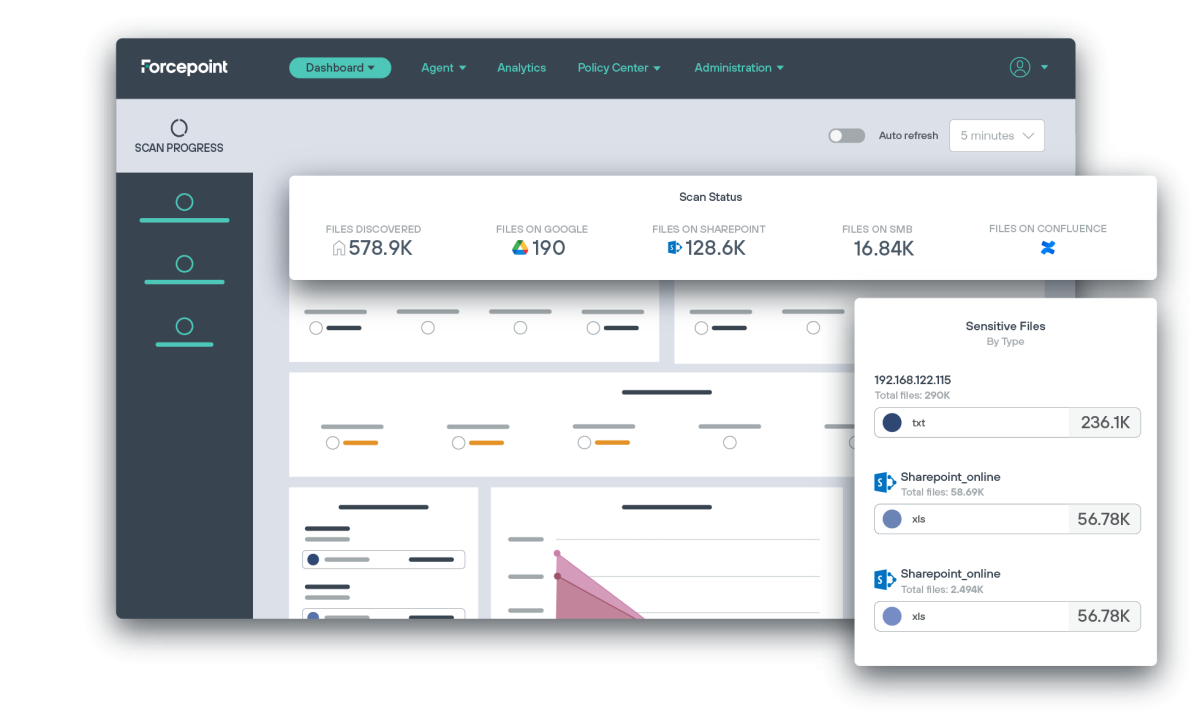
Data Security Posture Management
Forcepoint Data Security Posture Management (DSPM), unlocks total control and visibility over enterprise data. Discover, classify and orchestrate data through AI-powered automation and machine learning to stop breaches and enforce compliance.
- Scan up to 300 files per second and scale up to one million per hour through cloud and on-premises storage sites.
- Uncover data risk such as data duplication, dark data, incorrect file storage or permissions, and remediate in near real time.
- Deliver highly accurate classification accuracy through artificial intelligence and use machine learning to continuously improve the model's precision.
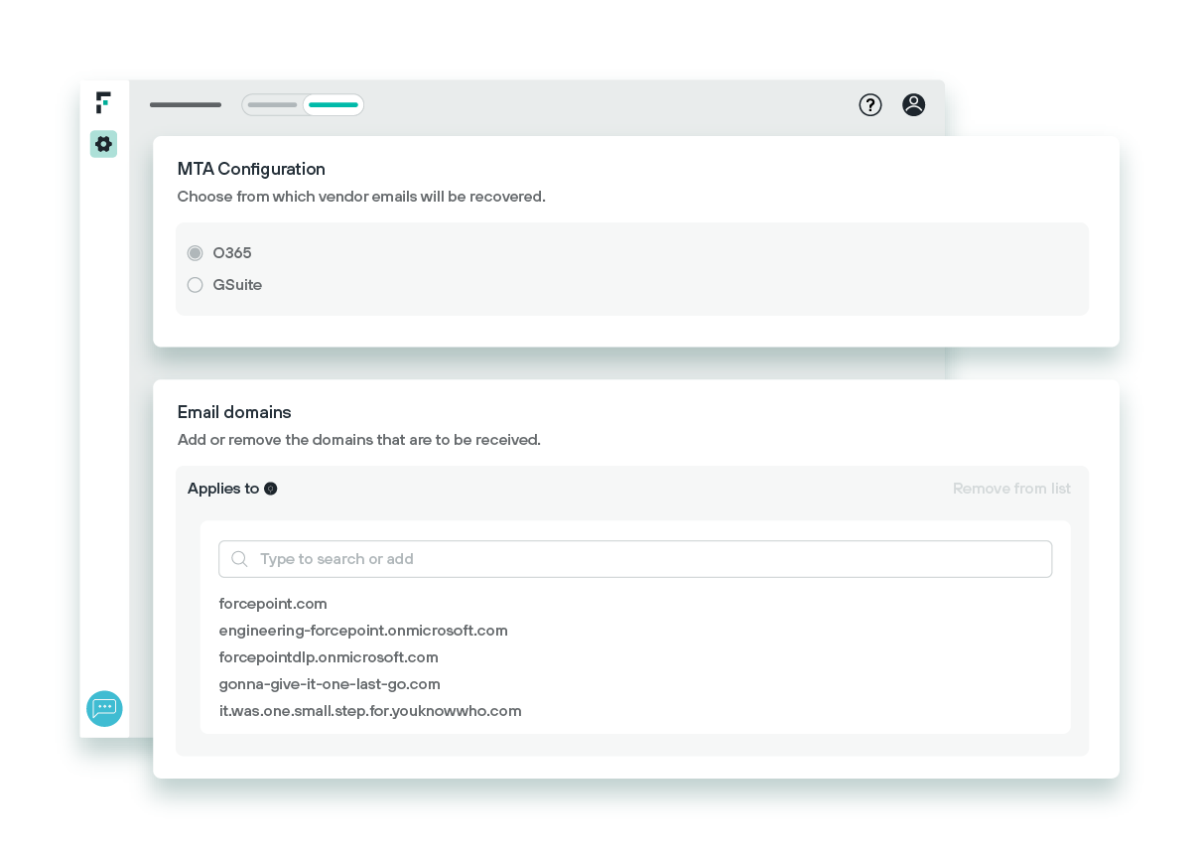
DLP for Email
Forcepoint DLP for Email enables enterprises to extend DLP policies to outbound email – the most common source of data loss. This provides:
- Coverage of 1,700+ classifiers and pre-built policy templates
- Agentless control on M365 Exchange, Google Workspace and other platforms
- Enhanced native functionality and capabilities of email administration
Comparing and Evaluating Data Security Tools
There are many unique use cases that organizations gravitate toward DLP and other data security solutions to solve. While analysts like Forrester, Gartner and Radicati release market analyses regularly to keep buyers’ up to date on the latest innovations, a feature comparison chart can be just as valuable.
Forcepoint has completed a feature comparison chart that contrasts Forcepoint DLP functionality with that of well-known vendors such as Symantec, Trellix and Microsoft.
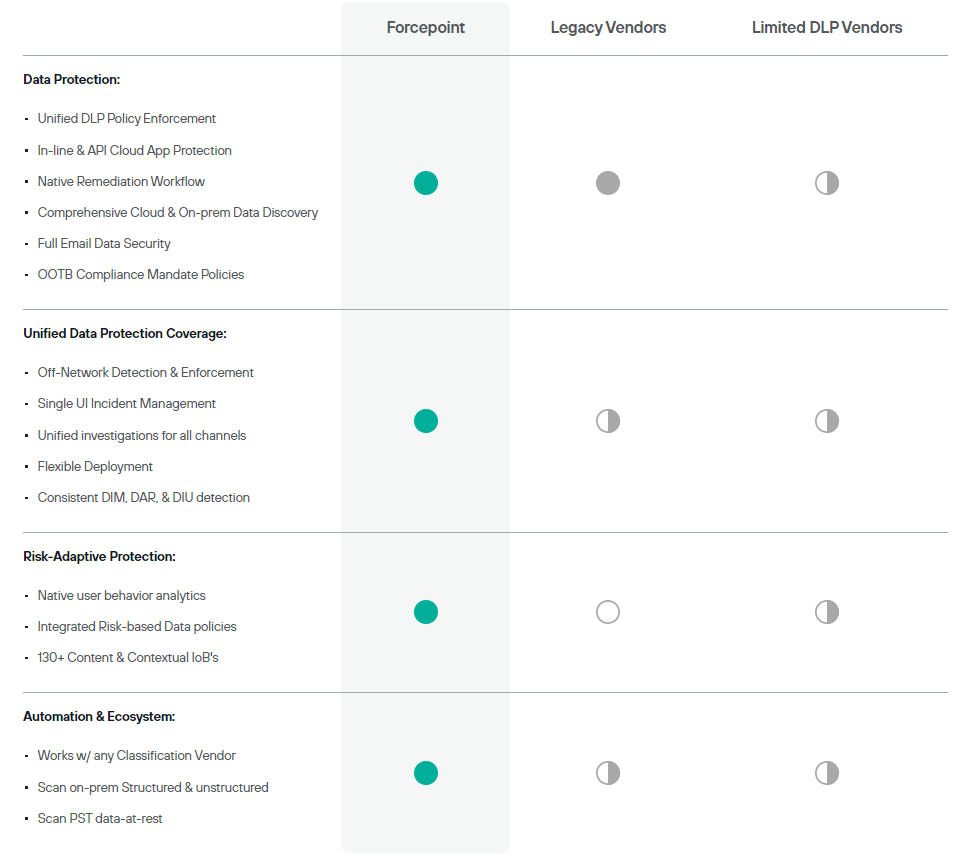
Discover how easily you can secure data everywhere.
How to Implement Data Security Everywhere
Data security requires a comprehensive approach to be most effective given the range of risks – and threat vectors – the average enterprise faces on a daily basis.
Data Security Everywhere is Forcepoint’s answer, allowing people to work anywhere in the world while accessing data everywhere it resides, safely.
The Five Steps to Data Security Everywhere
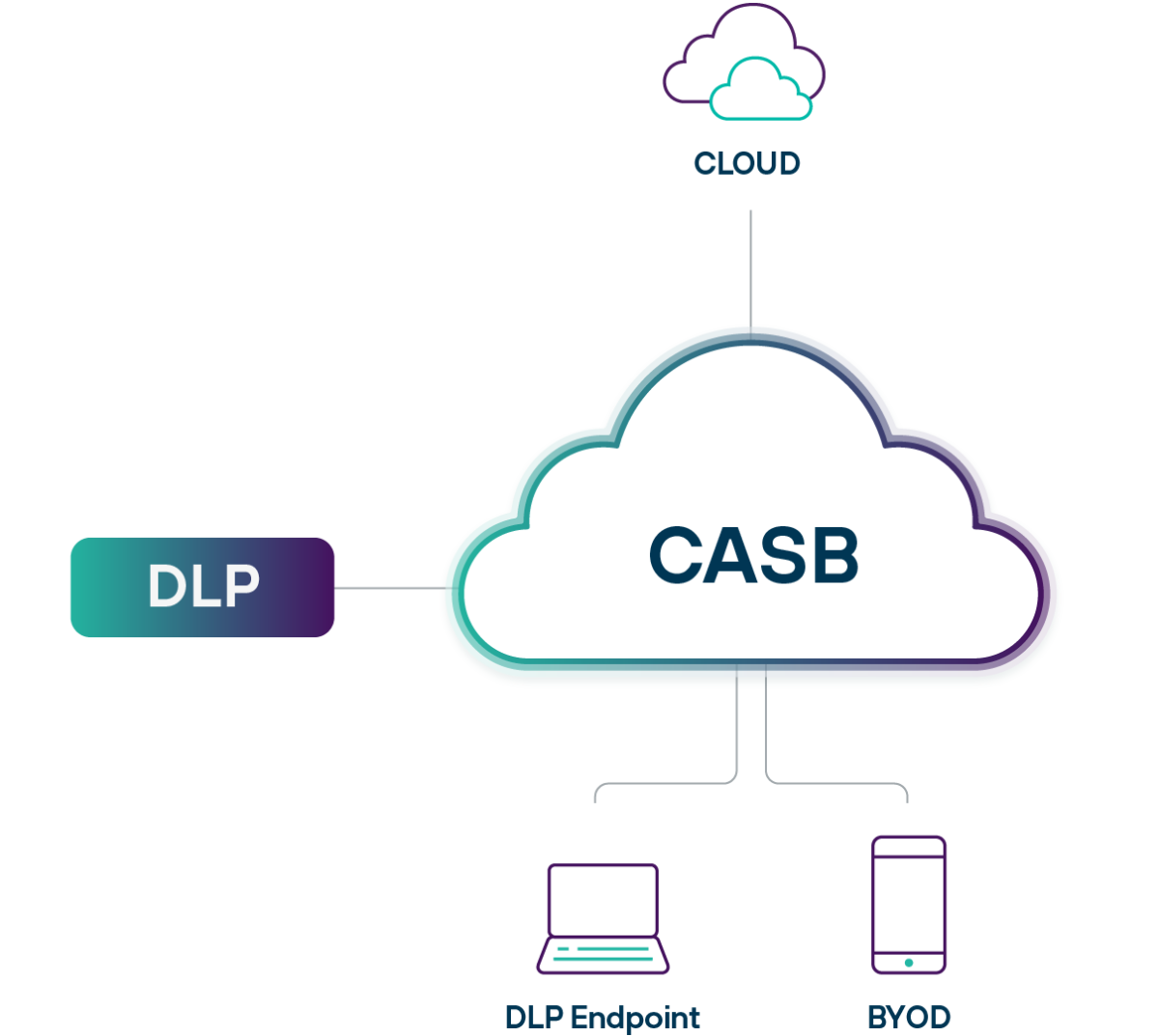
Unify Cloud, Endpoint and BYOD Data Protection
Forcepoint DLP and Forcepoint ONE CASB enable enterprises to scale DLP to users everywhere and unify cloud, endpoint and BYOD data protection. Take advantage of the largest collection of classifiers and pre-built policies in the industry and replicate policies with just a few clicks.
Extend DLP policies to over 800,000 cloud applications on both managed and unmanaged devices
Enforce policies on unmanaged devices and within unmanaged web apps
Eliminate multiple DLPs and the pain-staking process of manually syncing policies between them
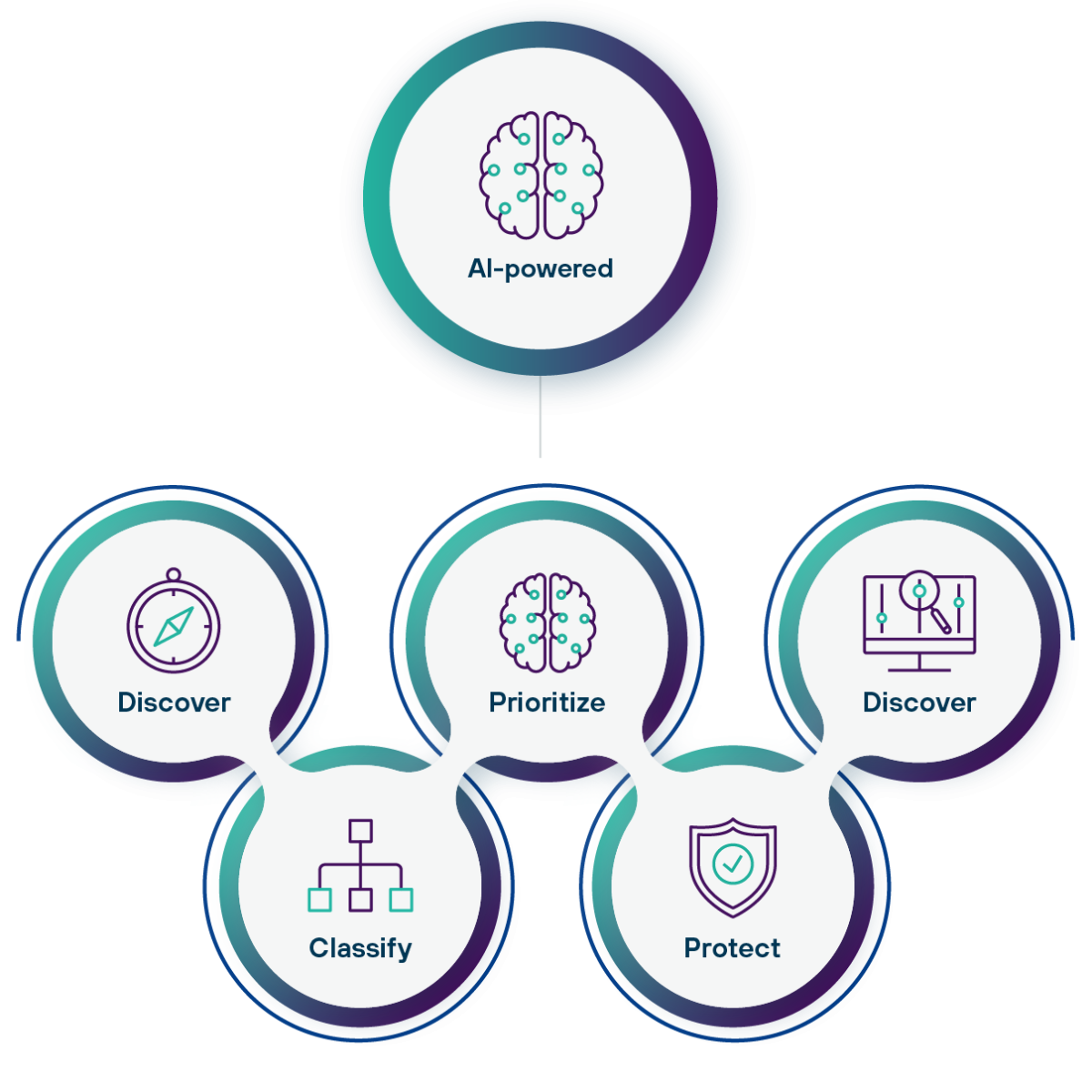
AI-powered Data Discovery and Classification
You can’t protect what you can’t see. Discover and secure unstructured data and classify and protect sensitive data across the business using AI-powered automation to get better visibility and control, reduce risk and streamline compliance.
Locate and classify data accurately and efficiently with machine learning and artificial intelligence
Categorize data using 70+ fields and within 50+ file types
View user permissions, file locations and more to prevent incidents and implement Zero Trust
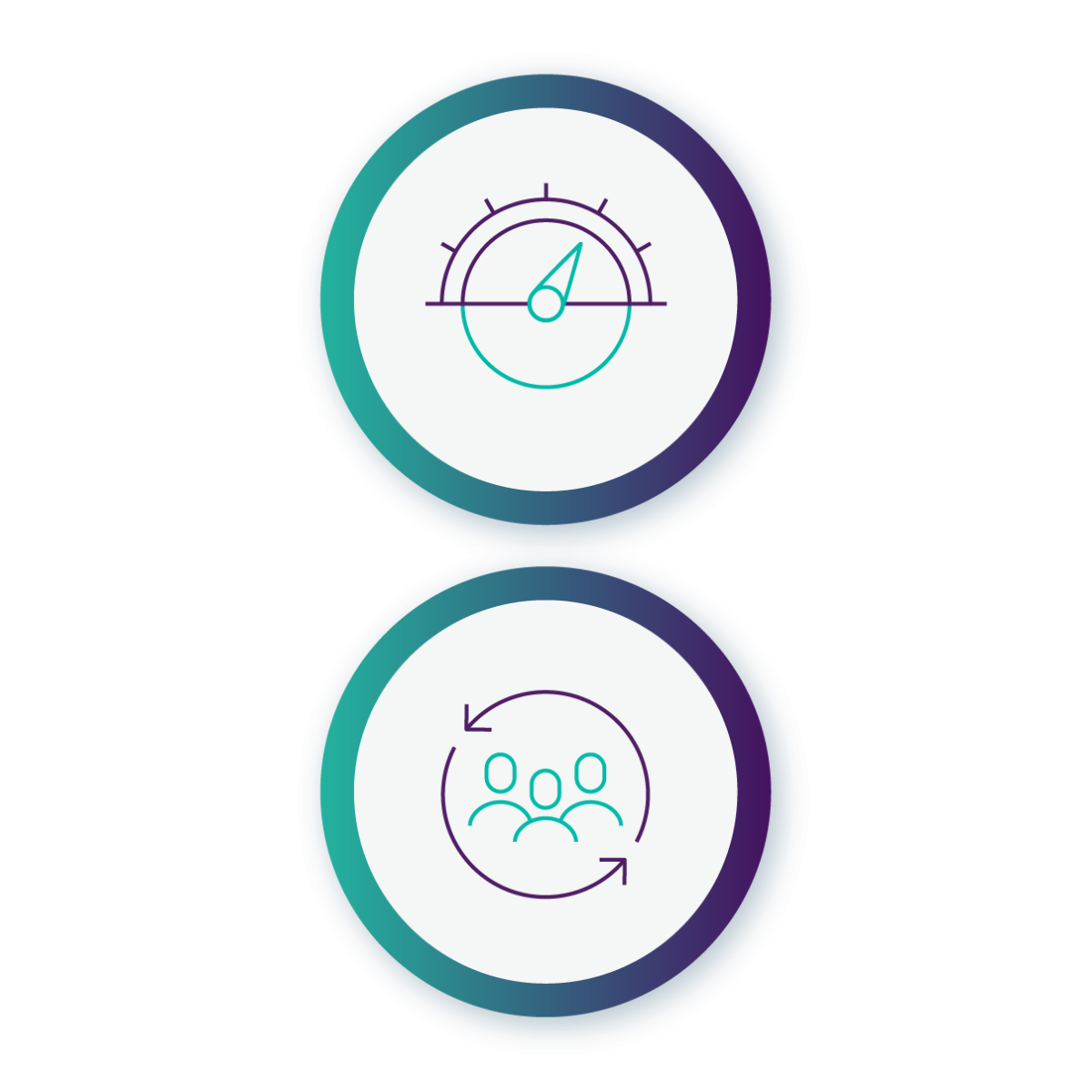
Automate Data Security Based on Risky Behavior
Automatically adapt policies based on risky user behavior to stop insider threats and prevent data breaches or leaks in real time. Risk-Adaptive Protection enables enterprises to unlock productivity and reduce false alerts with dynamic policy control.
Assign actions from self-learning to blocking based on risky activities
Adjust policies in real time based on context of user behavior
Reduce false positive alerts without limiting employees
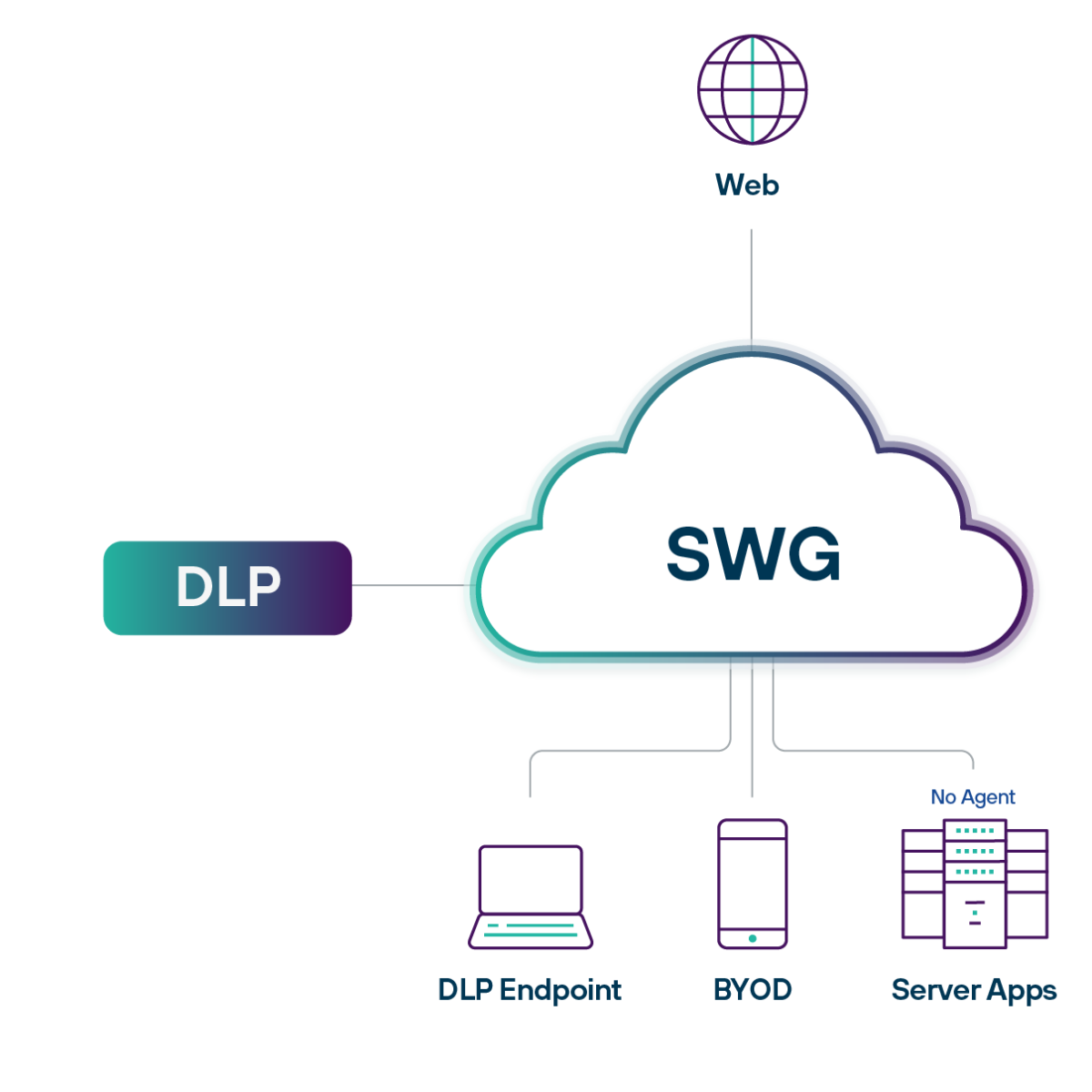
Protect Users and Data on the Web
The web presents two dangers to data: ransomware and exfiltration. Keep users and data safe by preventing known and unknown malware attacks, as well as stopping upload of sensitive data to web storage and applications.
Stop malware attacks by opening potentially risky websites in containers
Inspect and control data uploaded to web storage and applications
Eliminate multiple data security tools and the manually policy syncing needed between them
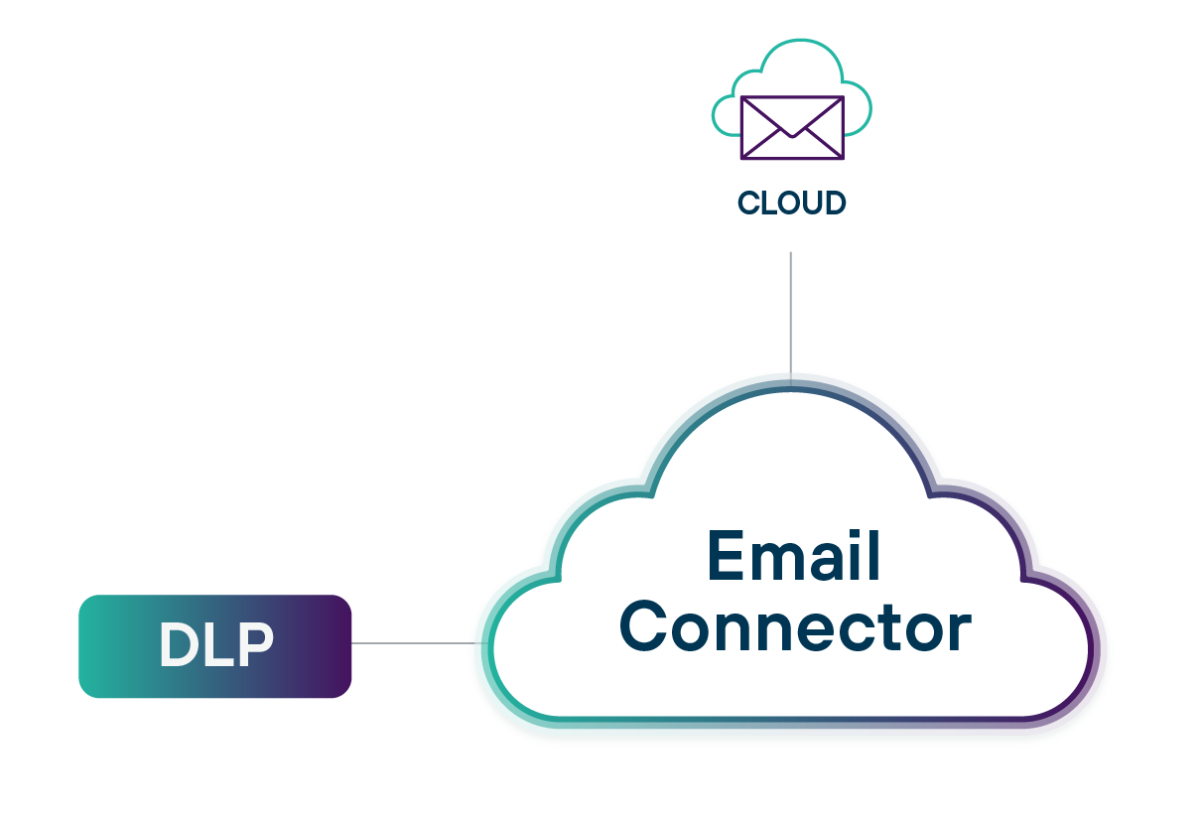
Prevent Data Theft in Outbound Email
Email is the No. 1 source of data exfiltration. Extend DLP policies to outbound email to stop sensitive data from exiting the organization, while improving native functionalities and capabilities of existing email administration.
Deploy in minutes on M365 Exchange, Google Workspace, and other popular platforms
Get visibility and control over what data can be shared via email
Enhance capabilities such as quarantine, encryption and more
Data Security Best Practices
Best Practices for Securing Data Everywhere
With Forcepoint DLP, organizations can unify policy management from an on-premises deployment across cloud, web and private applications with just a few clicks. This makes it possible to manage multiple channels with a single policy and to rapidly extend policies to both managed and unmanaged devices, saving time and ensuring comprehensive data security. Access to Forcepoint’s database of over 1,600 DLP classifiers also offers granular policy enforcement for web, cloud and private apps, so you can secure data everywhere that users access it.
Managing data security across all these channels is optimized when you take advantage of Forcepoint ONE Data-first SASE, an all-in-one, cloud-native security platform. Forcepoint ONE enables a modular approach to data security, allowing organizations to start by deploying what they need most and to subsequently add more solutions over time. Managing all security functions through a single pane of glass makes it easy to monitor and control data flows across all channels. Forcepoint ONE also includes the Insights analytics platforms, which visualizes economic value creation in real time to quantify the benefits of your data security program.
Forcepoint DLP and Forcepoint ONE can also help businesses to use generative AI chatbots like ChatGPT and Bard without the risk of leaking critical data. Organizations can set policies on who has access to generative AI, prevent uploading of restricted files and block pasting of sensitive information. This frees up workers to enjoy the productivity gains offered by AI without losing control of intellectual property or other critical data.
Analysts on Industry-Leading Data Security Tools
No two data security solutions are created equal. Many practitioners turn to industry analysts like Gartner, Forrester and Radicati for guidance on the benefits and drawbacks of each data security vendor.
The best place to start is with widely recognized publications that helpfully survey the current state of the market and identify what the leading solutions are. Take a look:
Case Studies
Depending on your industry, company size or industry, data security requirements will vary widely from one company to another.
To see how real customers are putting Forcepoint solutions to work to protect data everywhere, examine these case studies selected from the collection on our website:
Frequently Asked Questions
What are the best practices for data security?
Data security best practices demand a comprehensive approach based on an integrated suite of solutions.
Adopt a sweeping approach to protecting data that encompasses:
- Discovering the data that needs protection, from endpoint to cloud.
- Classifying sensitive information to uncover hidden risk.
- Prioritizing a strong data security posture through exhaustive reporting.
- Protecting data in real-time with robust DLP policies.
- Monitoring interactions with data to maintain compliance.
While DLP is the most common data security technology, it isn’t the only solution that can make a powerful impact. Other best practice solutions to incorporate include:
- A solution that provides visibility of data – especially redundant, obsolete or trivial information – across the organization.
- The ability to classify data by public, sensitive or confidential, and track its usage throughout the business.
- Risk-adaptive policy protection, which uses context to delineate safe interactions from risky ones and adjusts policies appropriately.
What are the data security solutions and tools available?
There are dozens of data security solutions and tools available to businesses. When considering which solutions to adopt, strive to maintain strong controls surrounding access to applications where data resides. These include:
- Cloud security, such as a Cloud Access Security Broker (CASB).
- Web security, such as a Secure Web Gateway (SWG).
- Email security, such as DLP for Email.
- Endpoint security, such as DLP.
How to measure and demonstrate the effectiveness of your data security strategy?
An effective data security strategy will provide broad coverage of DLP policies, prevent false-positive alerts, and deliver detailed audits over incidents to see how employees are responding over time to any changes in your approach.
Forcepoint data security solutions offer teams detailed reporting through an easy-to-use dashboard. Some technologies, such as those in the Forcepoint ONE platform, benefit from unified reporting through Forcepoint Insights.
How to implement a data security policy?
Data security policies can be configured and maintained through a DLP solution. Watch “A Day in the Life of a Forcepoint DLP Administrator” to see how simple it is to create a policy within Forcepoint DLP.
Here’s a brief step-by-step guide on how to build a DLP policy in Forcepoint DLP:
- Discover and classify your data.
- Navigate to the correct policy level based on how you want it to trigger.
- Start a new policy from scratch or using a pre-defined template.
- Name the policy and add classifiers for what data and interactions it should monitor.
- Determine the severity that incidents would entail and any resulting actions.
- Identify sources to monitor, such as Active Directory or the network.
- Determine destinations to monitor, such as endpoint, web or cloud.
How to educate staff on data security?
Data security awareness training is key to educate staff about data security hygiene and best practices, as well as the cyber threats that put sensitive information at risk.
With Forcepoint DLP, administrators can work data security awareness training into their DLP policies as a response to an incident. If an employee were to try and attach a list of social security numbers to an email, for example, data security teams can enforce a pop-up explaining why that isn’t allowed, what a better method would be and provide further details on better data hygiene practices.
How to conduct a data security audit?
Companies must first know what sensitive information it has and where that information is located before conducting a data security audit. Forcepoint Data Visibility and Forcepoint Data Classification help organizations gain visibility of data everywhere in the organization and classify that data based on severity and risk, respectively.
Businesses can conduct rolling data security audits by reviewing the incidents tracked in their DLP. Each incident is logged, regardless of its severity and response. Over time, administrators can use the audits to spot patterns, adjust DLP policy coverage, and of course, maintain compliance with an array of regulations.
How to manage data security in the cloud?
Managing data security in the cloud comes down to being able to secure access and maintain visibility of the data that is used in the cloud.
Securing access is two-fold; allow people anywhere to access cloud applications everywhere and ensure only the people who explicitly need to use those applications have access to them.
A Cloud Access Security Brokers (CASB) is commonly used to provide secure access to cloud applications. Forcepoint ONE CASB includes strong data security controls to manage the data people use within Slack, Dropbox and other common platforms.
Forcepoint ONE is a Zero Trust platform that enables organizations to enforce the principle of least privilege. This limits the number of people allowed to access data in any given cloud application, keeping potential insider threats or threat actors away from accessing that sensitive information.
How does SASE improve data security in a cloud environment?
Secure Access Service Edge (SASE) brings together security services at the edge with networking solutions. However, data security is intrinsic to SASE in that the secure services that fall under SASE – Cloud Access Security Broker, Secure Web Gateway and Zero Trust Network Access – all converge under one key functionality: securing access to business-critical resources.
When Forcepoint ONE CASB, Forcepoint ONE SWG and Forcepoint ONE ZTNA are paired with Forcepoint DLP, organizations can implement data security policies everywhere it resides – the cloud, the web and in private web applications. This allows for a uniform data security strategy and consolidated policy management.
With all this in mind, SASE improves data security in a cloud environment by simplifying its implementation and maintenance. Organizations get all the benefits of SASE, like streamlined management and cost savings, as well as the reliability of a robust data security posture.

